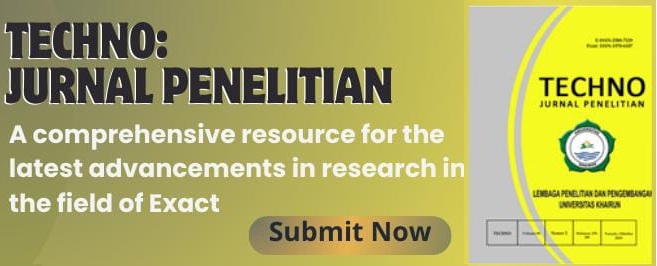Earthquake Hazard Mapping Based on Earthquake Intensity Model in North Maluku Islands
Abstract
Earthquake hazard mapping in the North Maluku region is urgent and essential because this area has a very high earthquake hazard potential. The high level of earthquake vulnerability in the North Maluku region makes it very important to focus mitigation activities to reduce the impact of earthquakes that occur. Earthquake hazard mapping that illustrates the effects of earthquakes on an area is one of the disaster mitigation efforts. In this study, earthquake intensity using the Probability Seismic Hazard Analysis (PSHA) method will be used to analyse the level of earthquake hazard in the North Maluku region. The results of the distribution of Peak Ground Acceleration (PGA) values for North Maluku range from 0.67 - 3.75 g. At the same time, the value of the MMI earthquake intensity scale is in the range of IX-XII. The most incredible earthquake intensity is in the Morotai, West Halmahera, Ternate, Tidore, Bacan, and Obi Island areas. The results of this study can have implications as a reference in safer spatial and infrastructure planning, the preparation of more effective mitigation strategies, and can be a medium for educating the public to be more prepared and responsive to earthquake risks.
Keywords
Full Text:
PDFReferences
Afnimar. (2009). Seismologi. Bandung: Bandung: Institut Teknologi Bandung.
Amelia, R., Pasongli, H., Latupeirissa, A. N., Saprudin, S., & Aswan, M. (2024). Multi-risk analysis of geological disasters in the jailolo coastal area as a disaster mitigation-based tourism development strategy. Jurnal Pendidikan, Sains, Geologi, dan Geofisika (GeoScienceEd Journal), 5(1), 68-74. https://doi.org/10.29303/goescienceed.v5i1.290.
Atkinson, G. M., & Boore, D. M. (2003). Empirical ground-motion relations for subduction-zone earthquakes and their application to Cascadia and other regions. Bulletin of the Seismological Society of America, 93(4), 1703-1729. https://doi.org/10.1785/0120020156.
Boore, D. M., & Atkinson, G. M. (2008). Ground-motion prediction equations for the average horizontal component of PGA, PGV, and 5%-damped PSA at spectral periods between 0.01 s and 10.0 s. Earthquake spectra, 24(1), 99-138. https://doi.org/10.1193/1.2830434.
Campbell, K. W., & Bozorgnia, Y. (2008). NGA ground motion model for the geometric mean horizontal component of PGA, PGV, PGD and 5% damped linear elastic response spectra for periods ranging from 0.01 to 10 s. Earthquake spectra, 24(1), 139-171. https://doi.org/10.1193/1.2857546.
Chiou, B. J., & Youngs, R. R. (2008). An NGA model for the average horizontal component of peak ground motion and response spectra. Earthquake spectra, 24(1), 173-215. https://doi.org/10.1193/1.2894832.
EERI Committee on Seismic Risk. (1989). The basics of seismic risk analysis. Earthquake Spectra, 5(4), 675-702. https://doi.org/10.1193/1.1585549.
Hamilton, W. (1979). Tectonics of the Indonesian Region. 4th edn. Washington: United States Government Printing Office.
Irsyam, M., Sengara I.W., Adiamar, F., Widiyantoro, S., Triyoso, W., Natawidjaja, D.H., Kertapati, E., Meilano, I., Suhardjono, Asrurifak, M., dan Ridwan, M. (2010). Ringkasan Hasil Studi Tim Revisi Peta Gempa Indonesia. Bandung: Tim Revisi Peta Gempa Indonesia.
McCaffrey, R. (1988). Active tectonics of the eastern Sunda and Banda arcs. Journal of Geophysical Research: Solid Earth, 93(B12), 15163-15182. https://doi.org/10.1029/JB093iB12p15163.
Merz, H.A. & Cornell, C.A. (1973). Aftershocks in engineering seismic risk analysis. Report R73-25. Massachusetts: Department of Civil Engineering. MIT. Cambridge.
Ningrum, R. W., Amelia, R. N., Hasmawati, H., Aswan, M., & Saprudin, S. (2021). Earthquake disaster risk assessment analysis in Jailolo Coastal region. Techno: Jurnal Penelitian, 10(2), 152-163. http://dx.doi.org/10.33387/tjp.v10i2.3523.
Ningrum, R. W., Amelia, R. N., Taib, S., Achmad, R., & Aswan, M. (2022). Mapping of seismic vulnerability potential for earthquake disaster migitation in South Morotai. Jurnal Geocelebes, 37-46. https://doi.org/10.20956/geocelebes.v6i1.19150.
Ningrum, R. W., Suryanto, W., Kamaruddin, B., Wahyudi, Sholihun, Wibowo, N. B., ... & Saprudin. (2024). Characteristics of earthquake hazards in Jailolo, West Halmahera, Indonesia: An analysis of b values and site dynamics. International Journal of Geophysics, 2024(1), 5594818. https://doi.org/10.1155/ijge/5594818.
Pownall, J. M., Hall, R., & Watkinson, I. M. (2013). Extreme extension across Seram and Ambon, eastern Indonesia: evidence for Banda slab rollback. Solid Earth, 4(2), 277-314. https://doi.org/10.5194/se-4-277-2013.
Pusgen. (2017). Peta Sumber Dan Bahaya Gempa Indonesia Tahun 2017 (Map of Indonesia Earthquake Sources and Hazards in 2017). Pusat Penelitian dan Pengembangan Perumahan Pemukiman. Badan Penelitian dan Pengembangan Kementerian Pekerjaan Umum dan Perumahan Rakyat.
Pusgen. (2022). Peta deagregasi bahaya gempa indonesia untuk perencanaan dan evaluasi infrastruktur tahan gempa. Jakarta: Direktorat Bina Teknik Permukiman dan Perumahan. Direktorat Jenderal Cipta Karya, Kementerian Pekerjaan Umum dan Perumahan Rakyat.
Richter, C. F. (1958). Elementary seismology. W. H. Freeman and Company. San Francisco and London, viii + 768 pp.
Saprudin, S., Achmad, R., Hamid, F., Ningrum, R. W., Aswan, M., Ayub, S., & Susilawati, A. (2024). Mobile-based interactive e-module: fostering earthquake swarms disaster mitigation awareness for junior high school students at West Halmahera Indonesia. Journal of Engineering Science and Technology. Special Issue on ISCoE2023, 19(2), 43-51.
Spakman, W., & Hall, R. (2010). Surface deformation and slab–mantle interaction during Banda arc subduction rollback. Nature Geoscience, 3(8), 562-566. https://doi.org/10.1038/ngeo917.
Sulaeman, C., & Cipta, A. (2012). Model intensitas gempa bumi di Maluku Utara. Jurnal Lingkungan dan Bencana Geologi, 3(2), 79-88. http://dx.doi.org/10.34126/jlbg.v3i2.38.
Widiwijayanti, C., Tiberi, C., Deplus, C., Diament, M., Mikhailov, V., & Louat, R. (2004). Geodynamic evolution of the northern Molucca Sea area (Eastern Indonesia) constrained by 3-D gravity field inversion. Tectonophysics, 386(3-4), 203-222. https://doi.org/10.1016/j.tecto.2004.05.003.
Wiemer, S. (2001). A software package to analyze seismicity: ZMAP. Seismological Research Letters, 72(3), 373-382. https://doi.org/10.1785/gssrl.72.3.373.
Youngs, R. R., Chiou, S. J., Silva, W. J., & Humphrey, J. R. (1997). Strong ground motion attenuation relationships for subduction zone earthquakes. Seismological research letters, 68(1), 58-73. https://doi.org/10.1785/gssrl.68.1.58.
Zhao, J. X., Zhang, J., Asano, A., Ohno, Y., Oouchi, T., Takahashi, T., ... & Fukushima, Y. (2006). Attenuation relations of strong ground motion in Japan using site classification based on predominant period. Bulletin of the Seismological Society of America, 96(3), 898-913. https://doi.org/10.1785/0120050122.
DOI: https://doi.org/10.33387/tjp.v13i2.9737
Refbacks
- There are currently no refbacks.
Copyright (c) 2024 Rohima Wahyu Ningrum, Rahim Achmad, Marwis Aswan, Wiji Raharjo

This work is licensed under a Creative Commons Attribution-NonCommercial 4.0 International License.
-------------------------------------------------------------------------------------------------------------------------------------------------------------------
-------------------------------------------------------------------------------------------------------------------------------------------------------------------
TECHNO: Jurnal Penelitian
Published by: LPPM Universitas Khairun
Addres : Jalan Yusuf Abdurrahman Kampus II Unkhair, Kelurahan Gambesi, 97722 Kecamatan Kota Ternate Selatan, Provinsi Maluku Utara, Email: techno@unkhair.ac.id | URL: http://ejournal.unkhair.ac.id/index.php/Techno
Techno Jurnal Penelitian is licensed under a Creative Commons Attribution-NonCommercial 4.0 International License.


























